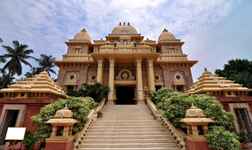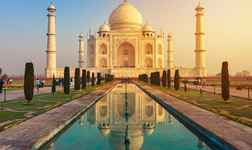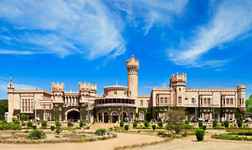More about hotels in India
India is part of the continent of Asia. Most of India forms a peninsula, which means it is surrounded by water on three sides. The world's highest mountain range, the Himalaya, rises in the north. The southeast is bordered by the Bay of Bengal, and the southwest is bordered by the Arabian Sea.
India's earliest known civilisation arose about 5,000 years ago on the Indus River in what is now Pakistan. Archaeologists uncovered the remains of two huge cities with brick houses, piped water, and sewer systems. Nobody knows why, but these cities, called Harappa and Mohenjo Daro, were abandoned in 1700 B.C.
The Aryan people were farmers from Central Asia who arrived in India around 1500 B.C. They spoke Sanskrit, one of the world's oldest known languages. The Vedic Scriptures, writings that form the basis of the Hindu religion, were written during the Aryan reign.
In the 200-year reign of the Gupta Empire, starting in the fourth century A.D., arts, crafts, and sciences flourished. During this time, the Indian astronomer Aryabhata determined that the Earth revolved around the sun. This was long before the Western world accepted the theory.
Beginning in the 16th century, following a series of invasions by Muslim forces, a Mongol leader named Babur founded the Mongol Empire. The Mongols oversaw a golden age of art, literature, and architecture in India between 1527 and 1707. They built roads, mosques, gardens, and enormous tombs, including the grand Taj Mahal.
In the late 1400s, Europeans arrived in India and began setting up trading companies. In 1757, Britain gained control over most of the country. Uprisings against British rule began in 1856. In 1920, the famous Mahatma Gandhi began nonviolent protests to push the British out. In 1947, India had independence.
Society throughout India is divided into social ranks, called castes. Caste is determined by birth, and there is almost no way to change it. High castes include priests, landowners, and soldiers. So-called Untouchables have no caste and do the most menial jobs.
India is a very spiritual country. It has no official religion, but more than 80 percent of Indians are Hindu. About 13 percent is Muslim. Other religions include Buddhism, Sikhism, and Jainism, which all began in India. For thousands of years, since the Hindu religion first evolved, respect for animal life has been an important part of Indians' beliefs. Cows, in particular, are sacred and cannot be harmed. They are even allowed to wander through city streets, which often cause traffic jams!
India's varied climate zones support about 65,000 animal species, including elephants, pythons, river dolphins, and rhinos, and 12,000 types of flowering plants. It is the only country in the world with both lions and tigers. It's also a bird watcher's paradise.
On the coast of the Bay of Bengal are the Sundarbans, the world's largest mangrove forest. Here, tigers swim in the same rivers as dolphins, sea turtles, sharks, and saltwater crocodiles. This unique landscape is constantly under threat as sea levels rise and humans hunt illegally and clear trees for firewood.
The Himalaya Mountains provide a home for some of India's rarest animals and plants. The most elusive animal is the snow leopard. Bears and black buck live lower down, and in the northeast, the tiger and one-horned rhinoceros can be found.
How to Get There?
By Flight
The tourists from Singapore need travel to India by plane. They need to take a flight from Changi Airport and can choose for transit flights or straight flights to India. The ticket price per person will be around $530 to $700 depends on your chosen airlines. However, the price of the ticket will be increased at the peak season, which is during the public holiday and school holiday season. The journey from Changi Airport to Indira Gandhi International Airport will be around 7 hours depends on your flight. Once they have arrived, they can grab a taxi and go straight to their place to stay. Before that, you must ensure that you have a visa before visiting India.
What to Do There?
Red Fort
The Red Fort or Lal Qila was constructed as the residence of Mughal Emperor Shah Jahan in 1648 and remained the home of Mughal leaders for 200 years until 1857. The fort was also used for imperial business, political and ceremonial events. At the time of construction, it was in the capital called Shahjahanabad (now old Delhi) as Shah Jahan had moved his capital from Agra. It gained its name the Red Fort from the red sandstone walls which surround the fort.
Within the red walls, there are imperial apartments created from a line of pavilions connected by the Stream of Paradise, a picturesque water channel. The architecture exhibits features of Persian, Timurid and Mughal styles. The fort complex covered 250 acres and was built using superior materials and created by master craftsmen. Over the years additions and changes were made to the structure, especially under the rule of Aurangzeb. The Red Fort exhibits the pinnacle of Mughal architecture and is a magnificent structure on the banks of the Yamuna River and adjacent to the Salimgarh Fort (1546).
Today, the fort houses several museums including the Freedom Struggle Museum, which focuses on the role the Red Fort played in the in the nation’s struggle for independence from 1857 to 1947. In the evenings, there is a spectacular Sound and Light show which brings to historical life events related to Delhi. The show covers the history of Delhi from Pandavas through British rule and to independence. The spectacular lasts an hour, and there are nightly shows in English and Hindu.
Qutb Complex & Qutub Minar
The Qutb Complex encompasses some monuments and buildings which are all part of a UNESCO site. The complex includes its most famous structure the Qutb Minar which was constructed under Qutb-ud-din Aibak (1150-1210) who went on to become the first Sultan of Delhi during the Mamluk Dynasty. A “minar” is a minaret, a tall tower-like structure used to call Muslim worshipers to prayer.
Qutb Minar is a red and buff sandstone conical tower, which stands 72 meters high and is 14.32 in diameter at the base and approximately 2.75 meters at the top. The minar (minaret) is the tallest brick minaret in the world and together with the surrounding ancient medieval structures are UNESCO site. The tower was built in 1192 constructed in the Indo-Islamic and Afgan architectural styles. There are 379 steps to the top of the minaret with five storeys. Although it has been hit by lightning several times and incurred damage from the elements, the tower has been restored over the years. On the first level of the tower, there is alternate circular and angular fluting and the fluting on the second level is circular.
The third level has angular fluting. Verses of the Koran are engraved on the tower walls. The tower’s balconies project out from the walls, adding to the tower’s beauty. The tower is still used to call Muslims to prayer. Close to the Qutb Minar is the remains of another tower called Alai Minar. Standing at the foot of the tower is the Quwwat-ul-Islam Mosque, the first mosque built in India. In the mosque courtyard is a tall iron pillar. Legend has it that if you put your arms around the pillar, your wishes will be granted. Other structures in the Qutb Complex include the Alai Minar; the Alai Gate; tombs of Alauddin Khilji, Imam Zamin and Iitutmish; the Iron Pillar and ruins of several Jain temples.
Humayun’s Tomb
Humayun’s Tomb dates back to the Mughal Empire (16th-18th century) and is the final resting place of Humayun (1508-1556) second Mughal Emperor and ruled over what is now Afghanistan, parts of northern India and Pakistan. Humayun’s son commissioned the tomb, which was designed by Mirak Mirza Ghiyas. This was the first garden tomb in India and the first to use red sandstone on a large scale. This UNESCO site includes the main tomb where Humayun, Bega Begum, Hamida Begum, Humayun’s great-great-grandson Dara Shikoh and several subsequent Mughal Emperors are buried. There are also several smaller structures set along the pathway leading to the main tomb. The tomb resembles a palace and is set among lush, well-maintained formal gardens in the Charbagh style. This is a traditional Persian-style garden layout divided into four sections by walkways with lawns, trees, flower beds and water features.
The beautiful tomb resembled a palace and was inspired by the Taj Mahal. The tomb stands on a raised platform and is constructed of red sandstone with the tomb itself made of black and yellow marble. Arches surround the entire lower level of the mausoleum. The building has two levels, and Humayun’s cenotaph is on the upper level in a room decorated with arched windows.
Lotus Temple
Among all the ancient attractions of New Delhi, this is one of the more recent additions. The Lotus Temple is a place of worship for followers of the Baha'i faith. Baha’i is a monotheistic faith which focuses on the spirituality of all humankind. It is based on the core principles that there is one God who is the source of creation; all major religions have the same spiritual source, and that humanity is diverse yet united, and all humans created equally. Baha’i was founded in 19th century Persia by Baha’u’llah.
The Lotus Temple was inaugurated in 1986; it has a beautiful structure inspired by the lotus flower with 27 freestanding petal-shaped marble structures arranged in groups of three forming a nine-sided shape with nine entrances leading into the main hall. Inside the hall is more than 40 meters high and can hold up to 2,500 worshipers. The structure follows architectural principles shared by all Baha’i Houses of Worship including the fact that there are nine sides, no statues; no pulpit and the exterior are clad in marble from Greece. The temple grounds cover 26 acres and include nine ponds and gardens. The temple is lit by solar power and has won numerous architectural awards. It is also considered one of the most visited structures in the world. The temple is open to visitors of all faiths, and the lotus flower structure was specifically chosen because it is part of the Hindu, Buddhist, Islamic and Jain religions.
Where to Stay?
ITC Maurya, a Luxury Collection Hotel, New Delhi
The ITC Maurya, a Luxury Collection Hotel, New Delhi has located in Sadar Patel, New Delhi, India. This hotel is situated 25-minutes away from the Indira Gandhi International Airport. This hotel offers a top class and very quality accommodation in the city of New Delhi. All of the rooms are well equipped with luxurious amenities such as flat-screen television with cable channels, a coffee or tea maker, hypo-allergic bedding, bathrobes, slippers, a private bathroom, and a tub. Besides that, the rooms are air conditioning, and the hotel has provided sofa beds, and the guests can request extra beds or infant beds.
Moreover, the guests can enjoy free international calls, and also a free Wi-Fi. The hotel has always kept the rooms clean since they offer a daily housekeeping service. If you have any questions to ask, their 24-hour front desk will always assist you in any related matter. After a long day trip to a few places in New Delhi, the guests can relax their mind and body by swimming at the provided pool. There is also a restaurant that serves different types of dishes which can meet the taste of most guests in ITC Maurya, a Luxury Collection Hotel, New Delhi.
The LaLiT New Delhi
As it is located 35-minutes away from the Indira Gandhi International Airport, The LaLiT New Delhi provides affordable accommodation in New Delhi. Every room in this hotel is well equipped with basic amenities. Besides that, the hotel provides the best facilities and services to make their guests feel more comfortable and convenient during their stays at this hotel. The guests can access free Wi-Fi from their room and also in the public area of the hotel. For those wanting to keep fit, there is a fitness centre available in this hotel. Other than that, the guests can go to the restaurant provided by the hotel.
The Corus Hotel
It is a perfect accommodation for a big family and also for those who want to stay a bit longer in New Delhi. The guests can freely use a few facilities that provided by the hotel. Every room in this apartment is equipped with amazing amenities such as a hairdryer, a television, electric kettle, an air conditioner, and refrigerator. There will be a 24-hour front desk to handle the process of check-in and out of the rooms. They are also available to help the guests in case if the guests need any assistance from them. They also can stay connected with their families and friends because there is a free Wi-Fi available in public area.












































 Facebook
Facebook Instagram
Instagram TikTok
TikTok Youtube
Youtube Telegram
Telegram